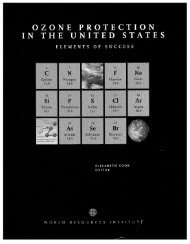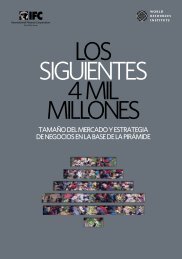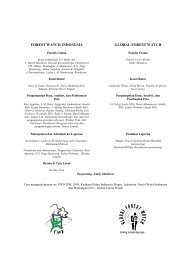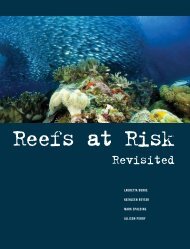GLObAL COAL RISK ASSESSmENT - World Resources Institute
GLObAL COAL RISK ASSESSmENT - World Resources Institute
GLObAL COAL RISK ASSESSmENT - World Resources Institute
You also want an ePaper? Increase the reach of your titles
YUMPU automatically turns print PDFs into web optimized ePapers that Google loves.
According to 2011 data, the top 10 countries from which<br />
China imports coal are Indonesia, Australia, Vietnam,<br />
Mongolia, North Korea, Russia, South Africa, the United<br />
States, Canada, and Colombia. 29<br />
Coal from Russia and Mongolia is mainly imported by rail<br />
and road. In 2011, Mongolia became the top coking coal<br />
exporter to China, overtaking Australia thanks to its lower<br />
prices. 30 Additional transport infrastructure developments<br />
have likely been proposed or are already underway, but<br />
detailed information is difficult to obtain.<br />
Coal from Canada, Colombia, North Korea, and the United<br />
States arrives in China primarily through the seven major<br />
northern coal ports (Qinhuangdao, Tianjin, Jingtang,<br />
Huanghua, Qingdao, Rizhao, and Lianyungang). These<br />
ports are also used to transport coal to southern China,<br />
Japan, and South Korea.<br />
The southern coastal areas, in particular Guangdong and<br />
Fujian provinces, import coal from Australia, Indonesia,<br />
South Africa, and Vietnam. Because of the high cost of<br />
transporting coal domestically, it is usually cheaper for<br />
Guangdong and Fujian to purchase coal from abroad. 31<br />
In the north the seven major ports and a number of smaller<br />
ones, including Yingkou and Weifang, have announced<br />
expansion plans for the 12 th Five-Year Plan (2011–2015). 32<br />
In the south, three ports (Zhuhai, 33 Fujian, 34 and Meizhou 35 )<br />
have also announced expansion plans that could enhance<br />
their capacities to accommodate more coal imports.<br />
Indonesia<br />
Indonesia is the most important supplier of steam coal<br />
in the Pacific market and exports to China, India, Japan,<br />
South Korea, and Taiwan. 36 Most of coal mines in Indonesia<br />
are located on Kalimantan Island and Sumatera Island.<br />
To promote mining development, new policies have been<br />
enacted that simplify licensing and clarify responsibilities<br />
among central, provincial, and district authorities. The<br />
“coal contracts of work” licensing system grants contract<br />
holders exploitation rights to a coal deposit for 30 years<br />
and royalty payments equal to 13.5 percent of the coal<br />
price. With help from the government, coal production has<br />
grown remarkably in the past decade. 37 An additional 60<br />
Mtpa of export mining capacity is projected by 2016. 38<br />
On Kalimantan Island, there are six large deepwater ports:<br />
Adang Bay, Banjarmasin, Kotabaru, Pulau Laut, Tanjung<br />
Global Coal Risk Assessment<br />
Bara, and Tarahan. Together, they have a total handling<br />
capacity of 268 Mtpa. Smaller coal terminals across the<br />
country have a total capacity of 60 to 80 Mtpa. So far,<br />
physical infrastructure has not constrained exports from<br />
Indonesia for two reasons. First, most of the coal deposits<br />
that have been developed are close to the coast. Second,<br />
domestic coal is transported by road or river, which makes<br />
railway construction for coal transport unnecessary.<br />
Adoni Global has announced plans to build a 250-kilometer<br />
(km) railway and a port with 60 Mtpa throughput<br />
capacity in the Sumatra region. 39 In the long run, inland<br />
infrastructure may need to be improved as coal mines<br />
further from the coast are exploited. 40 As of now, the flexibility<br />
of its inland transport system enables Indonesia to<br />
respond faster than its main competitors—Australia and<br />
South Africa—to new markets in China and India. 41<br />
South Africa<br />
South African coal is cost competitive and the country’s<br />
location makes it a convenient swing supplier between the<br />
Pacific and the Atlantic markets. South Africa exports coal<br />
mainly to Europe (including Belgium, Denmark, France,<br />
Germany, Italy, Netherlands, Portugal, Spain, Switzerland,<br />
and the United Kingdom), but an increasing share<br />
is going to the East (mainly India, but also China, South<br />
Korea, Malaysia, Pakistan, and Taiwan). It also supplies<br />
a small amount of coal to several countries in the Middle<br />
East, Africa, and Latin America. 42<br />
Most of South Africa’s coal mines are located in the Central<br />
Basin. 43 The expanded or recently developed Waterberg,<br />
Limpopo, and Soutpansberg Basins will further<br />
boost coal production. 44 Total mining capacity may reach<br />
132 Mtpa by 2016, up from 79 Mtpa in 2010. 45<br />
South Africa’s rail system has long been considered the<br />
main constraint on exports. The Richards Bay terminal<br />
was recently expanded to handle 91 Mtpa of coal exports,<br />
although its real utilization rate is much lower because of<br />
the lack of rail capacity to the coast. 46<br />
Some of the rail system upgrades currently underway are<br />
expected to help alleviate these transport constraints. 47<br />
The development of South Africa’s coal transport system<br />
has four key components: the Waterberg Feeder line,<br />
the coal backbone system through the Mpumalanga and<br />
Witbank area, the Richards Bay Coal Terminal coal export<br />
line, and the Swazilink system. 48<br />
WORKING PAPER | November 2012 | 15











